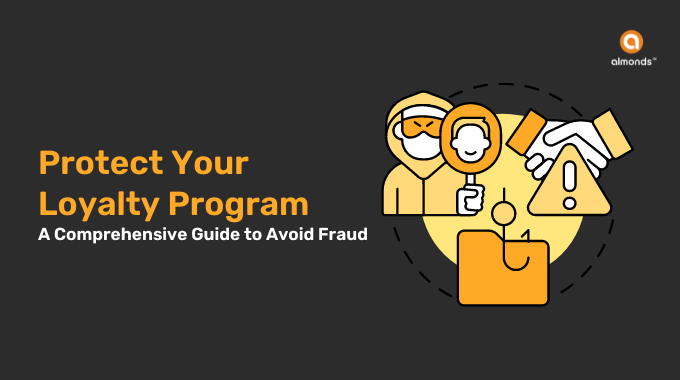Loyalty programs are a cornerstone of channel partner engagement and customer retention. They incentivize repeat purchases, foster brand loyalty, and offer valuable loyalty program insights. However, as these programs accumulate vast amounts of data – including personal information, purchase history, and spending habits – they become a tempting target for fraudsters.
That is why, here, even a single security breach can lead to devastating consequences, damaging brand reputation, eroding member trust, and potentially resulting in financial losses.
This comprehensive guide equips brands with the knowledge and strategies to safeguard loyalty programs and customer & channel partner data. Here, we’ll delve into the common security threats, explore best practices for building a robust defense system, and emphasize the importance of educating members about loyalty programs.
Understanding the Multifaceted Threat Landscape of Loyalty Fraud Prevention
Loyalty programs are susceptible to a variety of fraudulent activities. Understanding these risks is the first step towards building a secure environment. Here are some of the most prevalent threats:
- Account Takeover (ATO): Fraudsters employ various tactics, such as phishing attacks, exploiting weak passwords, or even system vulnerabilities, to gain unauthorized access to member accounts. Once in control, they can redeem points, steal sensitive information, or even use the account for further fraudulent activities.
- Fake Account Creation: Fraudsters might utilize automated bots to create a multitude of bogus accounts with the sole purpose of exploiting sign-up bonuses and promotional offers. It dilutes the program’s value for legitimate members and creates a financial burden for the brand.
- Point Theft: Unauthorized redemption or transfer of loyalty points can occur through various means, including account breaches or even internal collaborators. It can significantly inflate program costs and damage trust if points are unexpectedly depleted.
- Emerging Threats: The realm of cybercrime is constantly evolving. Staying informed about new threats, such as malware specifically designed to target loyalty programs, is crucial for maintaining a proactive security posture.
Building a Fortress: Essential Security Strategies
A secure loyalty management platform requires a multi-layered approach to protection. Here are some key strategies to fortify defenses:
- Implementing Strong Authentication Methods For Loyalty Fraud Prevention: Multi-factor authentication (MFA) acts as a powerful second layer of security. By requiring users to provide additional verification factors, such as a one-time passcode sent via text message or a fingerprint scan, access becomes significantly more difficult for unauthorized individuals.
- Enforcing Robust Password Policies For Loyalty Fraud Prevention: Encourage customers and channel partners to create strong, unique passwords and enforce password complexity requirements. Regular password updates further enhance security.
- Continuous Monitoring and Analysis: Real-time transaction monitoring tools can be invaluable in detecting unusual activity as it happens. It allows for a swift response to potential fraud attempts, minimizing damage. Additionally, leverage the power of data analytics to identify anomalous transaction patterns. Machine learning algorithms can be trained to detect suspicious activities and flag them for further investigation.
- Regular Security Audits and System Updates For Loyalty Fraud Prevention: Conducting periodic security audits of loyalty program infrastructure is paramount. These audits help identify and address security vulnerabilities before malicious actors can exploit them. Furthermore, ensure all software, including third-party integrations, is kept up to date with the latest security patches to mitigate known vulnerabilities.
The Importance of Security Awareness For Loyalty Fraud Prevention
A crucial element of any security strategy is loyalty program members’ education. Empowered customers and channel partners become valuable allies in the fight against fraud. Here’s how brands can educate them and encourage responsible security practices:
- Security Awareness Campaigns: Educate them about the importance of account security. Provide resources and tips on creating strong passwords, identifying phishing attempts (including email spoofing and suspicious links), and recognizing other red flags that might indicate fraudulent activity.
- Phishing Recognition Training For Loyalty Fraud Prevention: Use email campaigns and in-app notifications to educate them on how to recognize phishing attempts. Highlight common tactics used by fraudsters and encourage them to report any suspicious emails or activities to security teams.
Best Practices for Loyalty Program Management
Effective loyalty program management goes beyond just offering rewards. It involves implementing best practices that enhance security, operational efficiency, and, ultimately, channel partner trust. Here, we’ll delve into some key practices to safeguard the loyalty program and streamline its operations:
Fortressing Data: Encryption & Access Controls
- Data Encryption at Rest and in Transit: Ensure all sensitive data, including members’ information, purchase history, and loyalty point details, is encrypted using industry-standard protocols. It scrambles the data while it’s stored (at rest) and while it’s being transmitted (in transit), making it unreadable to unauthorized individuals in case of a breach.
- Granular Access Controls: Implement a layered approach to access control. Role-based access controls (RBAC) ensure that only authorized personnel have access to specific program functionalities based on their job responsibilities. It minimizes the risk of accidental data exposure or malicious activity by unauthorized users.
Combating Fraud in Loyalty Program
Loyalty programs, brimming with valuable member data and enticing rewards, are a magnet for fraudsters. However, fret no more! Cutting-edge tools powered by artificial intelligence (AI) and machine learning (ML) empower brands to stay a step ahead of these malicious actors.
- AI & ML for Predictive Analytics For Loyalty Fraud Prevention: Imagine having a crystal ball that unveils potential fraud attempts before they occur. That’s the power of AI and ML in loyalty program security. These technologies analyze vast amounts of program data, identifying anomalies and predicting suspicious activity in real time. It allows brands to flag potential threats before any damage is inflicted, safeguarding their loyalty and rewards program and members’ information.
- Automated Threat Detection & Alerting For Loyalty Fraud Prevention: Gone are the days of tedious manual monitoring. Advanced fraud detection tools constantly scan program activity, acting as vigilant sentinels. When they encounter suspicious behaviour, they trigger immediate alerts, enabling teams to take swift action and thwart potential fraud attempts. This swift response minimizes the risk of losses and protects the integrity of the loyalty program.
- Risk Scoring & Prioritization: These advanced tools go beyond simply identifying threats – they prioritize them. By assigning risk scores based on the severity of suspicious activity, they help allocate resources efficiently. It allows brands to focus a team’s efforts on the most critical cases, ensuring a targeted and effective response to potential fraud.
Responding to Loyalty Program Security Incidents for Loyalty Fraud Prevention
Even with the best security measures in place, security incidents can still occur. Having a well-defined incident response plan is paramount to minimizing the impact and ensuring a swift recovery:
- Comprehensive Incident Response Plan: Develop a detailed plan specifically tailored to address security breaches within the loyalty program. This plan should outline clear steps for incident identification, containment, eradication, and recovery. Crucially, it should also define communication protocols and escalation procedures to ensure all stakeholders are informed and involved in the response effort.
- Prompt Member Notification: Here, Transparency is key.
In a security incident, promptly notify affected members and give clear guidance on how to secure their accounts. It could involve password resets, multi-factor authentication activation, or other security measures. Be transparent about the nature of the incident, the steps brands are taking to address it, and how they are working to prevent future occurrences. - Continuous Improvement through Post-Incident Analysis: Security is an ongoing process.
Following a security incident, conduct a thorough post-incident analysis to understand the root cause and identify areas for improvement. Use these insights to update security posture, strengthen defenses, and prevent similar breaches from happening again.
Advanced Security Measures for Loyalty Management Platforms
As threats evolve, so should the security measures. Here are some advanced strategies to further protect the loyalty management platform:
1. Behavioral Analytics
Leverage behavioural analytics to understand the typical behaviour within the rewards program. It allows brands to identify deviations from normal patterns that might indicate fraudulent activity. For example, unusual spending patterns, sudden location changes, or attempts to access accounts from unrecognized devices can all be red flags.
2. Device Fingerprinting
Implement device fingerprinting to track the devices used to access the loyalty program. This technology creates a unique identifier for each device, allowing it to identify and block unauthorized devices attempting to access accounts.
3. Geofencing For Loyalty Fraud Prevention
Utilize geofencing to restrict access to loyalty programs based on geographic location. It can be particularly helpful if programs have a regional focus or if suspected fraudulent activity originates from specific locations. By restricting access from unauthorized regions, brands add an extra layer of security.
4. Tokenization
Tokenization replaces sensitive data, such as credit card numbers or account IDs, with unique identifiers (tokens) that hold no meaning on their own if intercepted. It protects sensitive information during transactions and reduces the risk of data breaches even if tokens are compromised.
Building a Culture of Security
Building a secure loyalty program management platform goes beyond firewalls and encryption. It thrives on a foundation of security awareness and a dedicated company culture. Here’s how to cultivate this essential mindset within the organization:
1. Employee Training
Regularly equip employees with the knowledge and skills to be vigilant guardians of loyalty program members’ data. Conduct security awareness training programs that educate them on best practices, potential threats, and their role in protecting sensitive information. Remember, a well-informed workforce is a powerful security asset.
2. Security Policies
Develop comprehensive security policies that govern every aspect of the loyalty program. These policies should outline clear guidelines for data handling, access controls, password management, and incident reporting. Regularly review and update policies to reflect evolving threats and ensure they remain relevant and enforceable.
3. Vendor Management
Third-party vendors and partners can be potential entry points for security vulnerabilities. To mitigate this risk, implement stringent vendor management practices. Conduct thorough assessments of their security posture before onboarding them and perform regular audits to ensure they adhere to security standards. By fostering a collaborative approach to security with vendors, brands can strengthen the overall security ecosystem of loyalty programs.
Future Trends in Loyalty Program Security
The landscape of loyalty program security is constantly in flux. Here are some cutting-edge trends to keep on brand radar:
- Artificial Intelligence and Machine Learning For Loyalty Fraud Prevention
Artificial intelligence (AI) and machine learning (ML) are poised to revolutionize loyalty program security. These powerful technologies can analyze vast amounts of program data to identify anomalies, predict potential fraud attempts, and proactively safeguard loyalty programs. By leveraging AI and ML, brands can move beyond reactive security measures and adopt a more preventative approach. - Blockchain Technology
Blockchain technology offers a secure and transparent way to manage loyalty programs. Its decentralized nature eliminates the need for a single point of failure, and its immutability ensures data integrity. By exploring the potential of blockchain, they can build a more robust and trustworthy loyalty program infrastructure.
- Biometric Authentication
Biometric authentication methods, such as fingerprint scanning and facial recognition, are becoming increasingly accessible and offer a high level of security. Integrating these technologies into loyalty programs can further strengthen access control and user authentication, adding another layer of protection against unauthorized access.
Conclusion
Protecting loyalty programs and members’ data from fraud and cyberattacks is essential for maintaining trust and ensuring the success of a loyalty program. By implementing strong authentication methods, monitoring transactions, conducting regular security audits, and educating customers, brands can create a secure loyalty management platform. Additionally, adopting best practices and advanced security measures will further enhance the rewards program’s security.
Stay ahead of emerging threats by continuously improving security measures and building a culture of security within a brand. By doing so, brands can ensure a secure and trustworthy experience for their members, safeguarding the integrity of their loyalty program.
For more detailed guidance on securing your loyalty program, contact us at almonds.ai.
Frequently Asked Questions
Here is some of the frequently asked questions for protections for Loyalty programs from security frauds and cyberattacks.
1. What are the common security risks associated with loyalty programs?
Loyalty programs face various security threats, including account takeover (ATO), fraudulent reward redemptions, phishing, and data breaches. Hackers often target the sensitive customer data stored in loyalty accounts, leading to identity theft and misuse of rewards.
2. How can businesses prevent loyalty fraud and account takeovers?
To prevent loyalty fraud, businesses should implement multi-factor authentication (MFA), strong password policies, and anomaly detection systems. Monitoring account activity for unusual behavior, like rapid point accumulation or redemptions, can help identify fraudulent attempts early.
3. What steps should businesses take to protect personal data in loyalty programs?
Businesses must ensure that customer data is encrypted and securely stored. Following industry regulations such as GDPR and conducting regular security audits can further protect against loyalty fraud. Minimizing the collection of sensitive information also reduces the potential for exposure.
4. How can businesses detect and prevent loyalty fraud in their programs?
Advanced fraud detection tools using machine learning can identify patterns indicating potential loyalty fraud, such as sudden increases in transactions. Businesses should also set limits on redemptions and manually review suspicious loyalty account activity to prevent fraud.
5. What measures can protect loyalty program members from phishing attacks?
To safeguard members from phishing attacks, businesses should educate customers on how to recognize fraudulent messages. Implementing secure communication protocols, such as DMARC, and providing guidance on verifying loyalty-related emails can help prevent phishing attempts.
6. How can businesses secure their loyalty program infrastructure from cyberattacks?
Businesses should regularly conduct vulnerability assessments, ensure secure APIs, and use firewalls to safeguard their loyalty program infrastructure. Penetration testing and software updates are critical steps in minimizing the risk of cyberattacks targeting loyalty programs.
7. What role does tokenization play in preventing loyalty fraud?
Tokenization enhances loyalty fraud prevention by replacing sensitive customer information with tokens that are meaningless if intercepted. This helps protect data during transactions and reduces the risk of cybercriminals accessing valuable information.
8. How can businesses secure third-party integrations involved in loyalty programs?
Businesses must thoroughly vet third-party vendors and ensure they comply with strict security standards. Using secure APIs and conducting periodic security audits of external integrations can prevent vulnerabilities in partnerships from leading to loyalty fraud.
9. How can businesses improve loyalty fraud prevention over time?
Businesses should regularly update their security protocols, invest in employee training, and adopt the latest cybersecurity technologies. Keeping up with new security threats and emerging fraud prevention strategies is essential for protecting loyalty programs from evolving cyber risks.
10. What should businesses do in the event of a loyalty fraud breach?
In the event of a loyalty fraud breach, businesses should immediately activate their incident response plan. This includes notifying affected customers, securing the compromised accounts, and conducting a detailed investigation. Strengthening security measures afterward is critical to prevent future breaches.







